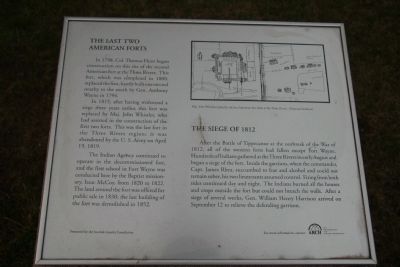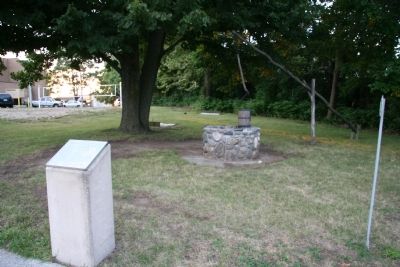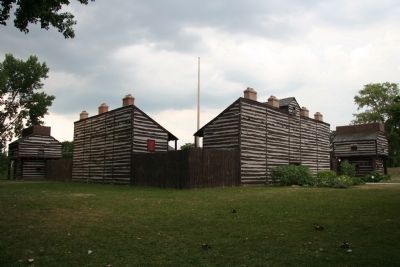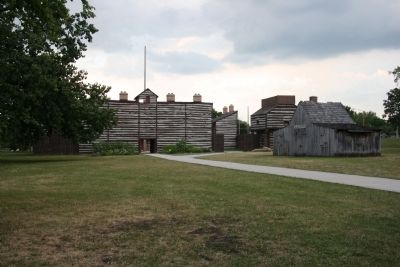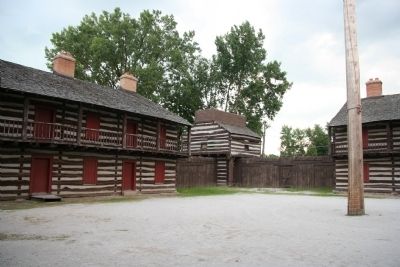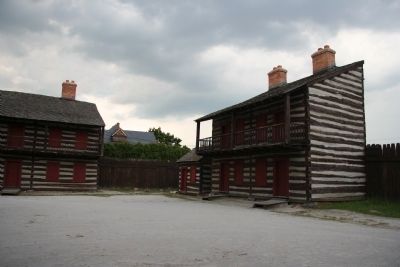East Central in Fort Wayne in Allen County, Indiana — The American Midwest (Great Lakes)
The Last Two American Forts / The Siege of 1812
Inscription.
The Last Two American Forts
In 1798, Col. Thomas Hunt began construction on this site of the second American fort at the Three Rivers. this fort, which was completed in 1800, replaced the first, hastily built one erected nearby to the south by Gen. Anthony Wayne in 1794.
In 1815, after having withstood a siege three years earlier, this fort was replaced by Maj. John Whistler, who had assisted in the construction of the first two forts. This was the last fort in the Three Rivers region; it was abandoned by the U. S. Army on April 1, 1819.
The Indian Agency continued to operate in the decommissioned fort, and the first school in Fort Wayne was conducted by the Baptist missionary, Isaac McCoy, from 1820 to 1822. The land aroun the fort was offered for public sale in 1830; the last building of the fort was demolished in 1852.
The Siege of 1812
After the Battle of Tippecanoe at the outbreak of the War of 1812, all of the western forts had fallen except Fort Wayne. Hundreds of Indians gathered at the Three Rivers in early August and began a siege of the fort. Inside the garrison, when the commander, Capt. James Rhea, succumbed to fear and alcohol and could not remain sober, his two lieutenants assumed control. Firing from both sides continued day and night. The Indians burned all the houses and crops outside the fort but could not breach the walls. After a siege of several weeks, Gen. William Henry Harrison arrived on September 12 to relieve the defending garrison.
Erected by the Journal-Gazzette Foundation.
Topics and series. This historical marker is listed in these topic lists: Forts and Castles • Native Americans • Settlements & Settlers • War of 1812 • Wars, US Indian. In addition, it is included in the Former U.S. Presidents: #09 William Henry Harrison series list. A significant historical month for this entry is April 1850.
Location. 41° 4.888′ N, 85° 8.032′ W. Marker is in Fort Wayne, Indiana, in Allen County. It is in East Central. Marker is at the intersection of East Main Street and Clay Street, on the right when traveling west on East Main Street. This historical marker is located in downtown Fort Wayne, just south of the Three Rivers area (where the St. Mary's and St. Joseph's Rivers come together to form the Maumee River) and is situated just east of the downtown fire station building and in front of the "Old Fort Wayne Well.". Touch for map. Marker is in this post office area: Fort Wayne IN 46802, United States of America. Touch for directions.
Other nearby markers. At least 8 other markers are within walking distance of this marker. Old Fort Wayne Well (here, next to this marker); First Central Fire House (within shouting distance of
this marker); The History of the Bell (within shouting distance of this marker); The Site of General Wayne's Fort (about 400 feet away, measured in a direct line); Takaoka and Fort Wayne Time Capsule (about 700 feet away); Mother George (about 700 feet away); This Barr And Columbia Street Intersection (approx. 0.2 miles away); Barr And Columbia (approx. 0.2 miles away). Touch for a list and map of all markers in Fort Wayne.
Also see . . .
1. Fort Wayne, Indiana. Absolute Astonomy.com - encyclopida article with several additional links for Fort Wayne informational sites. (Submitted on July 29, 2009, by Dale K. Benington of Toledo, Ohio.)
2. Forts of Fort Wayne, Indiana. This web link is published by Wikipedia, the free encyclopedia. (Submitted on July 29, 2009, by Dale K. Benington of Toledo, Ohio.)
Credits. This page was last revised on February 4, 2023. It was originally submitted on July 29, 2009, by Dale K. Benington of Toledo, Ohio. This page has been viewed 4,094 times since then and 42 times this year. Photos: 1, 2, 3, 4, 5, 6. submitted on July 29, 2009, by Dale K. Benington of Toledo, Ohio. • Syd Whittle was the editor who published this page.
